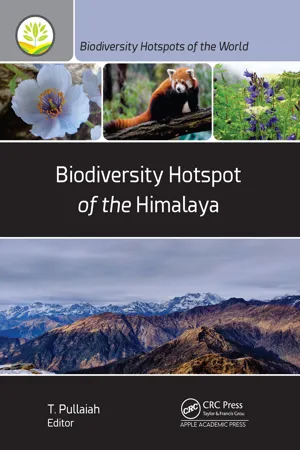
- 538 pages
- English
- ePUB (mobile friendly)
- Available on iOS & Android
Biodiversity Hotspot of the Himalaya
About this book
Biodiversity is declining at an alarming rate due to anthropogenic activities around the world. This book is the second volume in the new series Biodiversity Hotspots of the World, which highlights the 36 hotspot regions of the world, regions that have been designated as reaping maximum benefit from preservation efforts. This series is our humble attempt to document these hotspots as a conservation and preservation measure.
The concise volumes in this series focus on the most interesting and important properties of these hotspots, covering physiography and climatology; vegetation and forest types; amphibian and reptile biodiversity; genetic diversity of crops, plants, fishes, butterflies, insects, birds, mammals, angiosperms, and gymnosperms; and much more. And of course, the unique threats and conservation efforts for the areas are addressed as well.
The Himalayan Mountains are the highest mountain range in the world and include Mount Everest as well as eight other highest peaks of the world. While it is difficult to document the biodiversity of this inhospitable terrain, we do know that out of the 9, 000 different species of plants recorded in the area, 3, 500 plants are endemic to the Eastern Himalaya region. Anthropogenic activities including deforestation, fragmentation of habitats, pollution, high population, climate change, and poaching of wildlife pose serious threats to the biodiversity of the region. The highlands have exceptionally rich biodiversity, high endemism, and over 160 globally threatened species, including the densest population of Bengal tigers and the three largest herbivores on the continent: the Asian elephant, greater one-horned rhinoceros, and wild water buffalo. The region boasts the world's richest counts of alpine flora within its temperate broad-leaved forests, with a total of 10, 000 species of plants.
This volume, Biodiversity Hotspot of the Himalayas, as well as the other volumes in this series, will be essential resources for researchers and practitioners in the fields of conservation biology, ecology, and evolution as the series concisely records the existing biodiversity of these hotspots of the world.
Frequently asked questions
- Essential is ideal for learners and professionals who enjoy exploring a wide range of subjects. Access the Essential Library with 800,000+ trusted titles and best-sellers across business, personal growth, and the humanities. Includes unlimited reading time and Standard Read Aloud voice.
- Complete: Perfect for advanced learners and researchers needing full, unrestricted access. Unlock 1.4M+ books across hundreds of subjects, including academic and specialized titles. The Complete Plan also includes advanced features like Premium Read Aloud and Research Assistant.
Please note we cannot support devices running on iOS 13 and Android 7 or earlier. Learn more about using the app.
Information
Table of contents
- Cover Page
- Half Title page
- Title Page
- Copyright Page
- About the Book Series Biodiversity Hotspots of the World
- About the Editor
- Contents
- Contributors
- Abbreviations
- Preface
- 1 The Himalayan Biodiversity Hotspot: Geomorphology, Biogeography, and Climate
- 2 Cyanobacteria from The Himalayan Biodiversity Hotspot: Diversity, Endemism, and Future Scopes
- 3 Algal Diversity of the Eastern Himalaya
- 4 Algal Diversity of the Western and Central Himalaya
- 5 Checklist of Polypores and Corticioides on Oaks and Other Hardwoods of the Himalaya and Its Foothills
- 6 Current Status of Lichen Diversity in the Himalayan Biodiversity Hotspot
- 7 Liverwort and Hornwort Diversity in the Himalayan Biodiversity Hotspot in India
- 8 Distribution Patterns of Planktonic and Benthic Fauna and Their Drivers Along the Himalayan Elevational Gradients
- 9 Status and Trends Of Herpetofaunal Diversity in the Himalaya Biodiversity Hotspot
- 10 Diversity Of Turtles In The Eastern Himalaya
- 11 Butterflies of the Indian Himalaya Along with Nepal and Bhutan
- 12 Birds of the Himalaya Biodiversity Hotspot: Diversity, Distribution, and Conservation
- 13 Diversity and Conservation Status of Primates in the Eastern Himalaya
- 14 Status of Soil Biota in the Himalayan Region: A Review
- 15 Status of Grassland and Its Management Scenarios in the Himalayan Global Biodiversity Hotspot with Special Reference to Manas Biosphere Reserve
- 16 Plant Diversity Status of the Himalayan Biodiversity Hotspots in Changing Climatic Conditions with Special Reference to the Indian Himalayan Region
- 17 Climate Change and Biodiversity in the Himalaya: Trends and Perception
- 18 Threats and Conservation of Plant Diversity in the Himalayan Biodiversity Hotspot
- Index